High-Temperature Zn-5Al Hot Dip Galvanizing of Reinforcement Steel
Abstract
:1. Introduction
2. Materials and Methods
2.1. Materials and Hot Dip Procedure
2.2. Characterization Methods
3. Results and Discussion
3.1. Growth Kinetics and Microstructure of Coatings
3.2. EDS and XRD Analysis
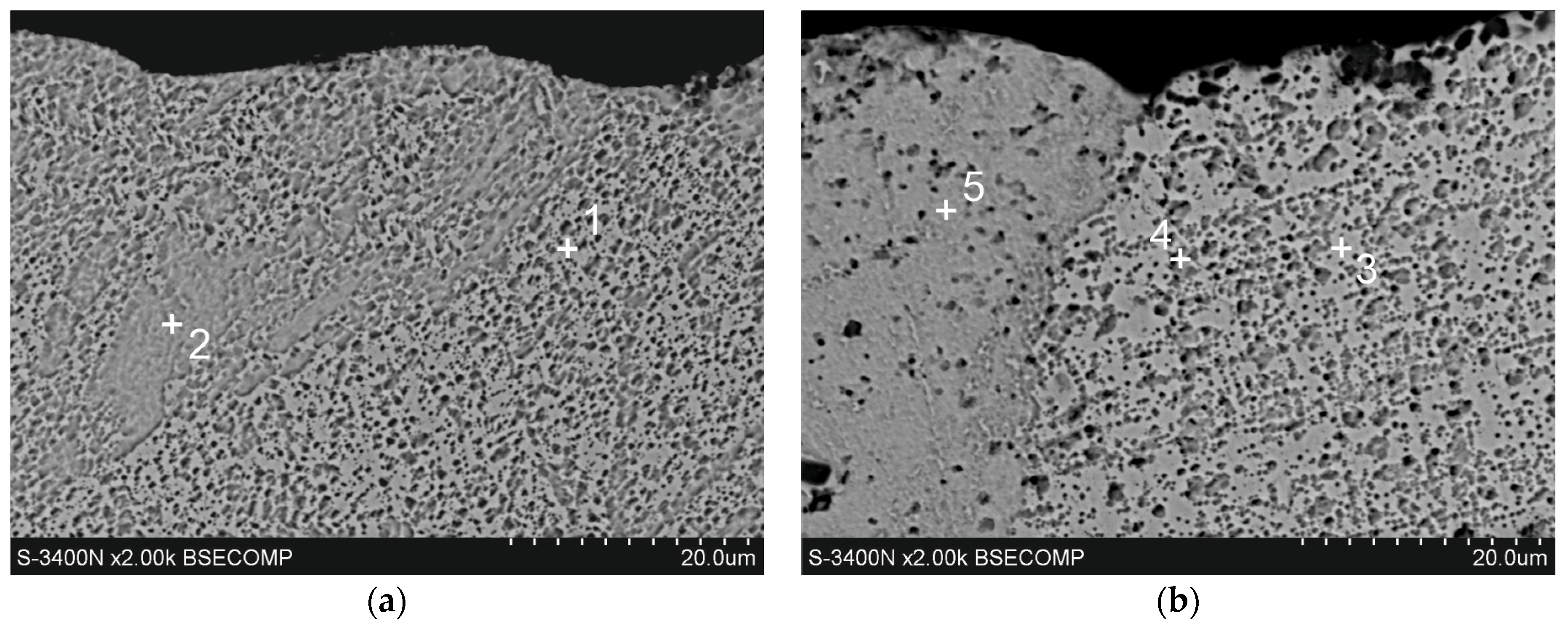
| Point No. | Al (at.%) | Fe (at.%) | Zn (at.%) | Phase |
|---|---|---|---|---|
| 1 | 0.9 | - | 99.1 | Zn-rich phase |
| 2 | 6.2 | - | 93.8 | Al-rich phase |
| 3 | 0.7 | - | 99.3 | Zn-rich phase |
| 4 | 3.9 | - | 96.1 | Al-rich phase |
| 5 | 10.6 | - | 89.4 | Al-rich phase |
| 6 | 68.9 | 24.7 | 6.4 | Fe(Al,Zn)3 |
| 7 | 0.2 | - | 99.8 | Zn-rich phase |
| 8 | 0.3 | - | 99.7 | Zn-rich phase |
| 9 | 69.5 | 25.2 | 5.3 | Fe(Al,Zn)3 |
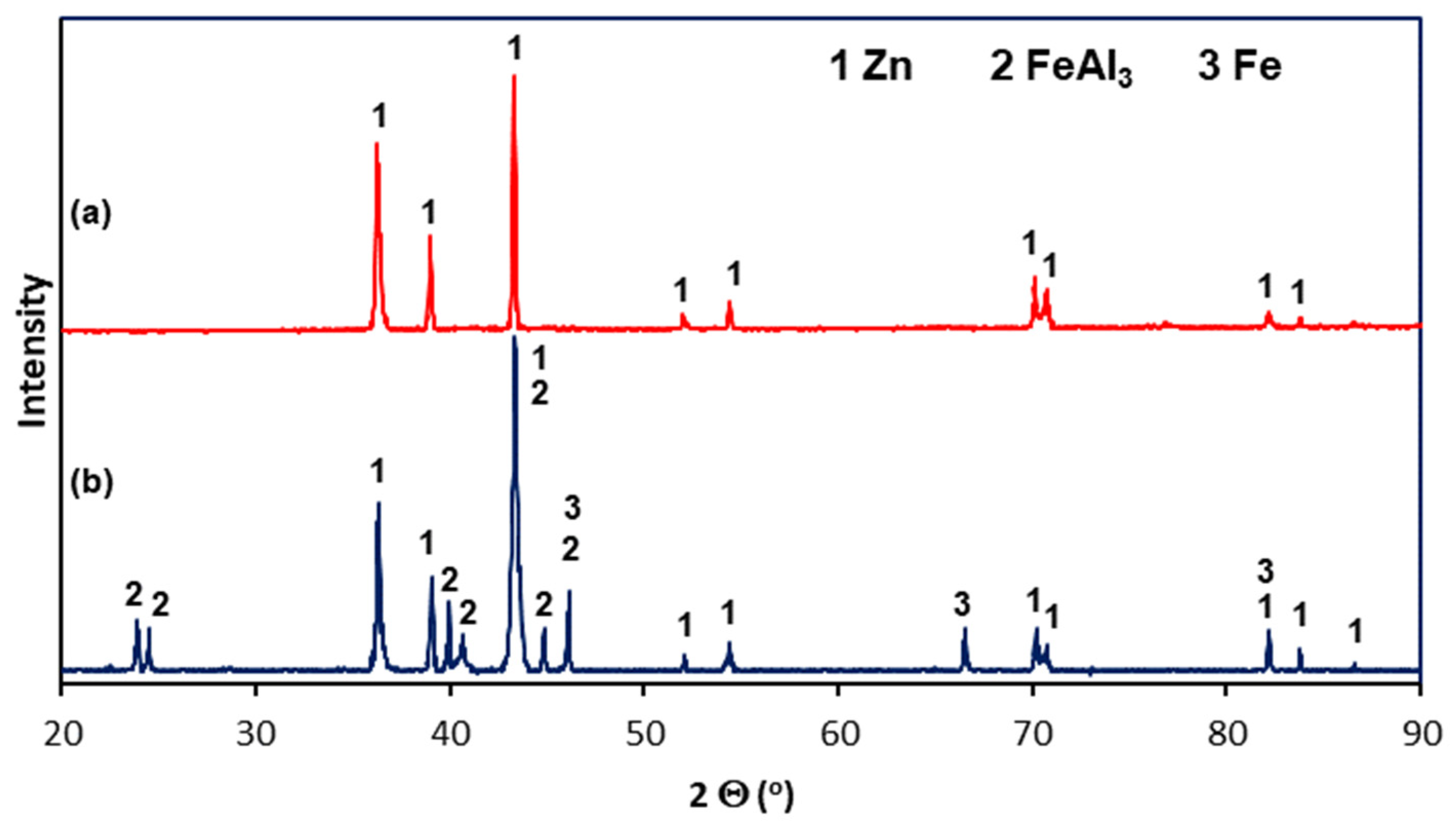

3.3. Corrosion Resistance and Corrosion Products
- -
- M2+—divalent metal cation;
- -
- M3+—trivalent metal cation;
- -
- An−—interlayer anion [24].
4. Conclusions
- The growth of high-temperature ZnAl-galvanized coatings takes place in two stages. In the initial stage, a compact diffusion layer of the coating is formed, and its growth is controlled by diffusion. In the second stage, the periodic layered structure is formed, the growth of which is close to linear. The time sequences of coating growth depend on the bath temperature, which, when raised, accelerates the sequence of formation of the periodic layered structure.
- High-temperature ZnAl-galvanized coatings exhibit a two-layer microstructure. A diffusion layer of Fe(Al,Zn)3 intermetallics is formed near the substrate, which is covered with an outer layer composed of Zn-rich and Al-rich areas.
- Zn-5Al coatings showed better corrosion resistance than conventional hot-dip-galvanized coatings due to the formation of favorable corrosion products. The NSS test showed that a layer of simonkolleite—Zn5(OH)8Cl2·H2O—and a layered double hydroxide (LDH) layer based on divalent cations of Zn2+, trivalent cations, and Al3+ and Cl− anions are formed on the coating surface. This configuration of corrosion products and the ease of exchange of cations and anions in LDH structures constitute an effective protective barrier, delaying the corrosion process in various corrosive environments.
Author Contributions
Funding
Institutional Review Board Statement
Informed Consent Statement
Data Availability Statement
Conflicts of Interest
References
- Gao, D.Y.; Tai, Y.Y.; Yang, L.; Zhang, Z.Q.; Liu, G.J.; You, P.B. Corrosion of steel fibers in chloride-contaminated simulated concrete pore solutions. J. Mater. Civ. Eng. 2023, 35, 04022429. [Google Scholar] [CrossRef]
- Yang, L.; Liu, G.J.; Gao, D.Y.; Zhang, C.X. Experimental study on water absorption of unsaturated concrete: W/c ratio, coarse aggregate and saturation degree. Construct. Build. Mater. 2021, 272, 121945. [Google Scholar] [CrossRef]
- Huet, B.; L’Hostis, V.; Miserque, F.; Idrissi, H. Electrochemical behavior of mild steel in concrete: Influence of pH and carbonate content of concrete pore solution. Electrochim. Acta 2005, 51, 172–180. [Google Scholar] [CrossRef]
- ISO 12944-5:2019; Paints and Varnishes—Corrosion Protection of Steel Structures by Protective Paint Systems—Part 5: Protective Paint Systems. International Organization for Standardization: Geneva, Switzerland, 2019.
- Schweitzer, P.A. Paint and Coatings: Applications and Corrosion Resistance; CRC Press: Boca Raton, FL, USA; Taylor & Francis Group: New York, NY, USA; Consultant York: Pennsylvania, PA, USA, 2005; pp. 34–114. [Google Scholar]
- Assaad, J.J.; Issa, C.A. Bond strength of epoxy-coated bars in underwater concrete. Construct. Build. Mater. 2012, 30, 667–674. [Google Scholar] [CrossRef]
- Yeomans, S.R. Use of galvanized rebars in RC structures. In A Presentation to a Seminar on Durability of Reinforced Concrete Structures; Standing Committee on Concrete Technology Civil Engineering and Development Hong Kong Government: Hong Kong, China, 2005. [Google Scholar]
- Cao, Y.; Gehlen, C.; Angst, U.; Wang, L.; Wang, Z.D.; Yao, Y. Critical chloride content in reinforced concrete—An updated review considering Chinese experience. Cement Concr. Res. 2019, 117, 58–68. [Google Scholar] [CrossRef]
- Liu, G.J.; Zhang, Y.S.; Ni, Z.W.; Huang, R. Corrosion behavior of steel submitted to chloride and sulphate ions in simulated concrete pore solution. Construct. Build. Mater. 2016, 115, 1–5. [Google Scholar] [CrossRef]
- Liu, Y.P.; Weyers, R.E. Modeling the time-to-corrosion cracking in chloride contaminated reinforced concrete structures. ACI Mater. J. 1998, 95, 675–681. [Google Scholar]
- Goodwin, F.E. An Update on Galfan. In Proceedings of the 14th International Galvanizing Conference, Munich, Germany, 9–14 June 1985. [Google Scholar]
- Massalski, T.B.; Okamoto, H. Binary Alloy Phase Diagrams, 2nd ed.; ASM International: Materials Park, OH, USA, 1990. [Google Scholar]
- Kim, K.-Y.; Grandhi, S.; Oh, M.-S. Improving the Coatability of Zn–Mg–Al Alloy on Steel Substrate by the Surface Pretreatment of SnCl2-Added Zinc Ammonium Chloride. Appl. Sci. 2023, 13, 950. [Google Scholar] [CrossRef]
- Kania, H. Structure Shaping and Corrosion Resistance of Zn-Al Coatings Obtained in Hot Dip Metalization; Silesian University of Technology: Gliwice, Poland, 2017. [Google Scholar]
- Gao, L.; Li, Z.; Kuang, X.; Yin, F.; Ji, H. Formation of periodic layered structure during hot-dip galvanizing in Al-Zn-Mg bath. Surf. Coat. Technol. 2016, 304, 306–315. [Google Scholar] [CrossRef]
- Schulz, W.D.; Thiele, M. General Hot-Dip Galvanizing; Leuze Verlag: Bad Saulgau, Germany, 2012. [Google Scholar]
- ISO 9227:2017; Corrosion Tests in Artificial Atmospheres—Salt Spray Tests. Polish Version PN EN ISO 9227:2017; Polish Committee for Standardization: Warszawa, Poland, 2017.
- Marder, A.R. The metallurgy of zinc-coated steel. Prog Mater Sci. 2000, 45, 191–271. [Google Scholar] [CrossRef]
- Zamanzadea, M.; Hasemannb, G.; Motza, C.; Krügerb, M.; Barnoushac, A. Vacancy effects on the mechanical behaviour of B2-FeAl intermetallics. Mater. Sci. Eng. A 2018, 712, 88–96. [Google Scholar] [CrossRef]
- Zamanzade, M.; Barnoush, A.; Motz, C. A Review on the Properties of Iron Aluminide Intermetallics. Crystals 2016, 6, 10. [Google Scholar] [CrossRef]
- Qian, W.J.; Gu, W.G. Inhibitory action of Si on growth of interfacial compound layer during hot-dip aluminizing. Acta Metall. Sin. 1994, 30, 404–408. [Google Scholar]
- Selverian, J.H.; Marder, A.R.; Notis, M.R. The effects of silicon on the reaction between solid iron and liquid 55 wt pct Al-Zn baths. Met. Trans. A 1989, 20, 543–555. [Google Scholar] [CrossRef]
- Kania, H.; Mendala, J.; Kozuba, J.; Saternus, M. Development of bath chemical composition for batch hot-dip galvanizing—A Review. Materials 2020, 13, 4168. [Google Scholar] [CrossRef]
- Evans, D.G.; Slade, R.C.T. Structural Aspects of Layered Double Hydroxides. In Layered Double Hydroxides. Structure and Bonding; Duan, X., Evans, D.G., Eds.; Springer: Berlin/Heidelberg, Germany, 2005; Volume 119. [Google Scholar] [CrossRef]
- LeBozec, N.; Thierry, D.; Persson, D.; Riener, C.K.; Luckeneder, G. Influence of microstructure of zinc-aluminium-magnesium alloy coated steel on the corrosion behavior in outdoor marine atmosphere. Surf. Coat. Technol. 2019, 374, 897–909. [Google Scholar] [CrossRef]
- Volovitch, P.; Allely, C.; Ogle, K. Understanding corrosion via corrosion product characterization: I. Case study of the role of Mg alloying in Zn–Mg coating on steel. Corros. Sci. 2009, 51, 1251–1262. [Google Scholar] [CrossRef]
- Eaves, D.R. A Study of Novel Filiform Corrosion Phenomena on Hot Dip Organically Coated Zn-Al-Mg Steel. PhD Thesis, Swansea University, Swansea, UK, 2013. [Google Scholar]
- Prosek, T.; Thierry, D.; Taxen, C.; Maixner, J. Effect of cations on corrosion of zincand carbon steel covered with chloride deposits under atmospheric conditions. Corros. Sci. 2007, 49, 2676–2693. [Google Scholar] [CrossRef]
- Hosking, N.C.; Ström, M.A.; Shipway, P.H.; Rudd, C.D. Corrosion resistance of zinc–magnesium coated steel. Corros. Sci. 2007, 49, 3669–3695. [Google Scholar] [CrossRef]
- Komatsu, A.; Izutani, H.; Tsujimura, T.; Andoh, A.; Kittaka, T. Corrosion resistanceand protection mechanism of hot-dip Zn–Al–Mg alloy coated steel sheet under accelerated corrosion environment. Tetsu-to-Hagane 2000, 86, 534–541. [Google Scholar] [CrossRef]
- Yang, D.; Chen, J.; Han, Q.; Liu, K.R. Effects of lanthanum addition on corrosion resistance of hot-dipped galvalume coating. J. Rare Earths 2009, 27, 114–118. [Google Scholar] [CrossRef]
- Chen, Y.; Shui, Z.; Chen, W.; Chen, G. Chloride binding of synthetic Ca–Al–NO3 LDHs in hardened cement paste. Construct. Build. Mater. 2015, 93, 1051–1058. [Google Scholar] [CrossRef]
- Li, K.F.; Zhang, D.D.; Li, Q.W.; Fan, Z.H. Durability for concrete structures in marine environments of HZM project: Design, assessment and beyond. Cement Concr. Res. 2019, 115, 545–558. [Google Scholar] [CrossRef]
- Costa, D.G.; Rocha, A.B.; Souza, W.F.; Chiaro, S.S.X.; Leitao, A.A. Comparative Structural, thermodynamic and electronic analyses of ZnAlAn−hydrotalcite-like (An− = Cl−, F−, Br−, OH−, CO32− or NO3−): An ab initio study. Appl. Clay Sci. 2012, 56, 16–22. [Google Scholar] [CrossRef]
- Zhao, X.J.; Zhu, Y.Q.; Xu, S.M.; Liu, H.M.; Yin, P.; Feng, Y.L.; Yan, H. Anion exchange behavior of M(II)Al layered double hydroxides: A molecular dynamics and DFT study. Phys. Chem. Chem. Phys. 2020, 22, 19758–19768. [Google Scholar] [CrossRef] [PubMed]
- LeBozec, N.; Thierry, D.; Rohwerder, M.; Persson, D.; Luckeneder, G.; Luxem, L. Effect of carbon dioxide on the atmospheric corrosion of Zn–Mg–Al coated steel. Corros. Sci. 2013, 74, 379–386. [Google Scholar] [CrossRef]
- Persson, D.; Thierry, D.; LeBozec, N.; Prosek, T. In situ infrared reflection spectroscopy studies of the initial atmospheric corrosion of Zn–Al–Mg coated steel. Corros. Sci. 2013, 72, 54–63. [Google Scholar] [CrossRef]
- Prosek, T.; Persson, D.; Stoulil, J.; Thierry, D. Composition of corrosion products formed on Zn–Mg, Zn–Al and Zn–Al–Mg coatings in model atmospheric conditions. Corros. Sci. 2014, 86, 231–238. [Google Scholar] [CrossRef]
- Kania, H.; Marek, A. Corrosion behavior of Zn-Al-Mg-Si coatings in sulfur dioxide-containing environment. Appl. Sci. 2024, 14, 2120. [Google Scholar] [CrossRef]
- Xu, Z.; Wu, Y.; Zhang, Z.; Wang, Y.; Hu, J.; Ma, Y.; Zhang, Z.; Huang, H.; Wei, J.; Yu, Q.; et al. A review on the research progress of LDHs as corrosion inhibitors for reinforced concrete. J. Build. Eng. 2023, 70, 106303. [Google Scholar] [CrossRef]
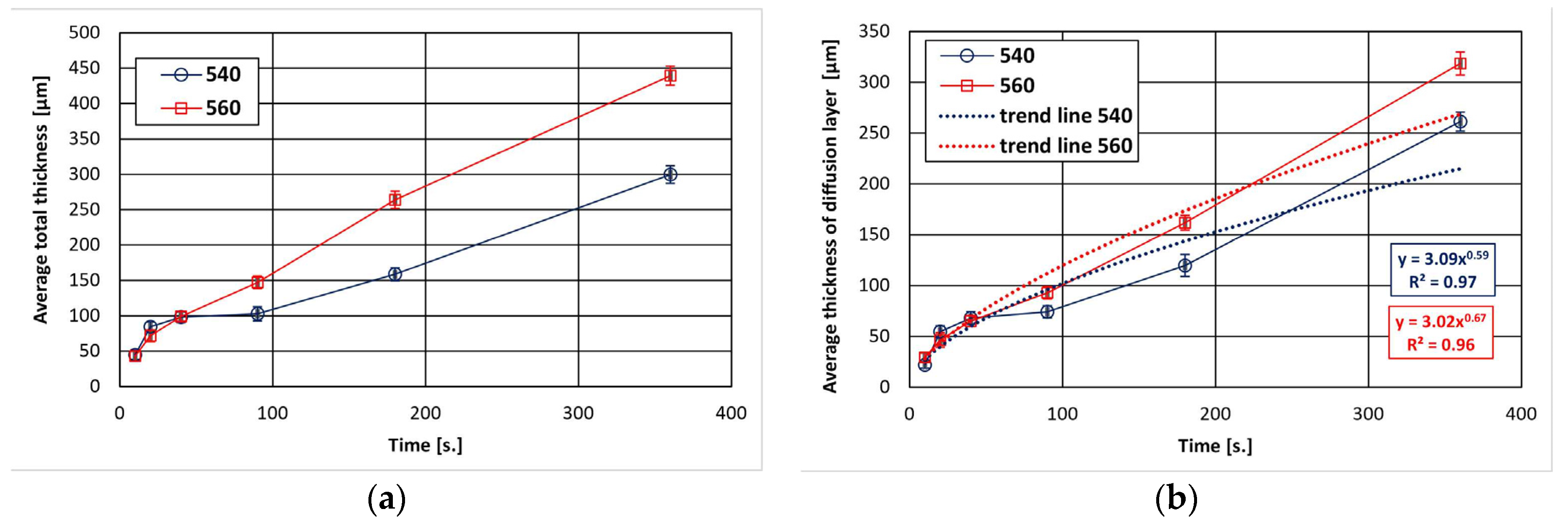
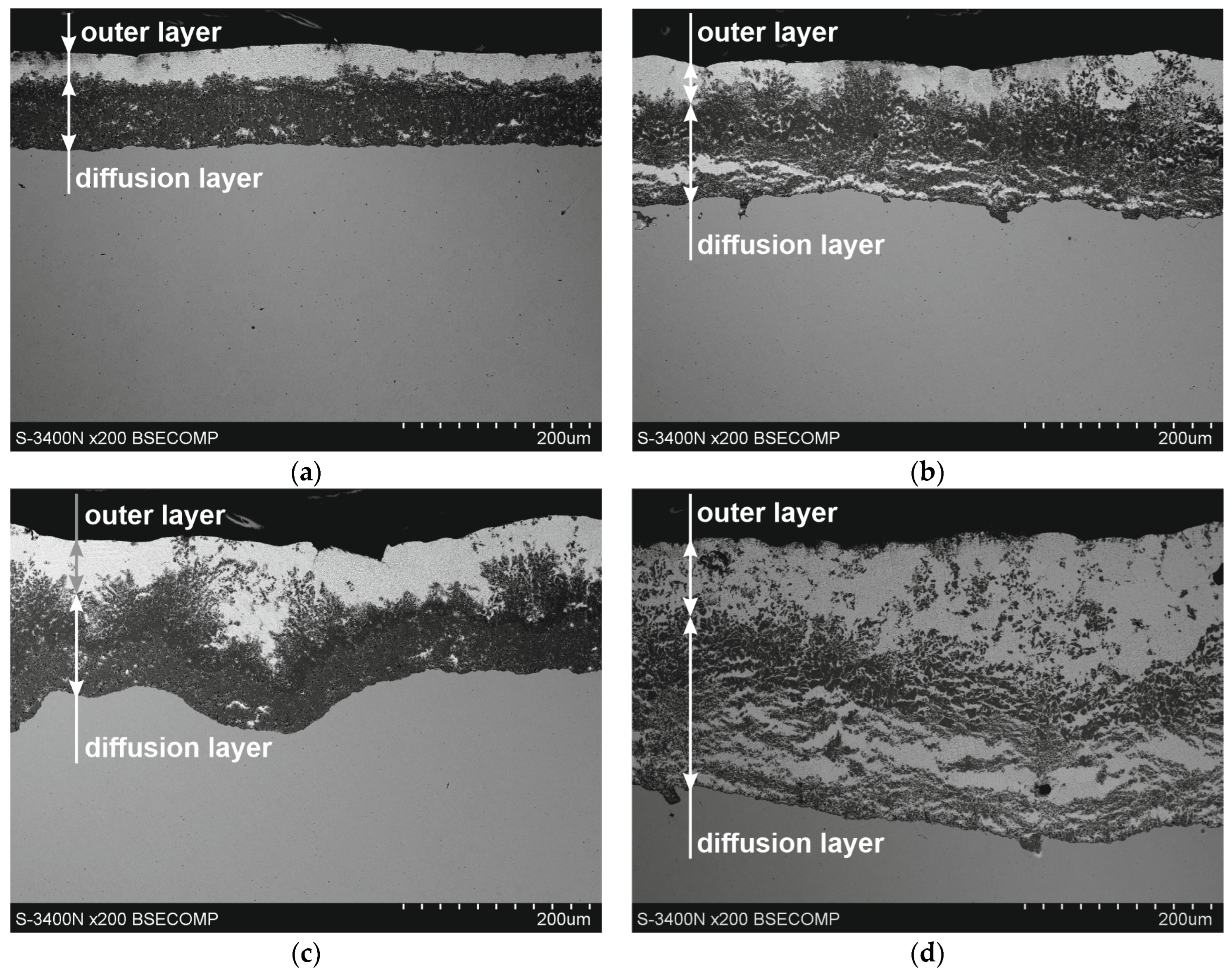
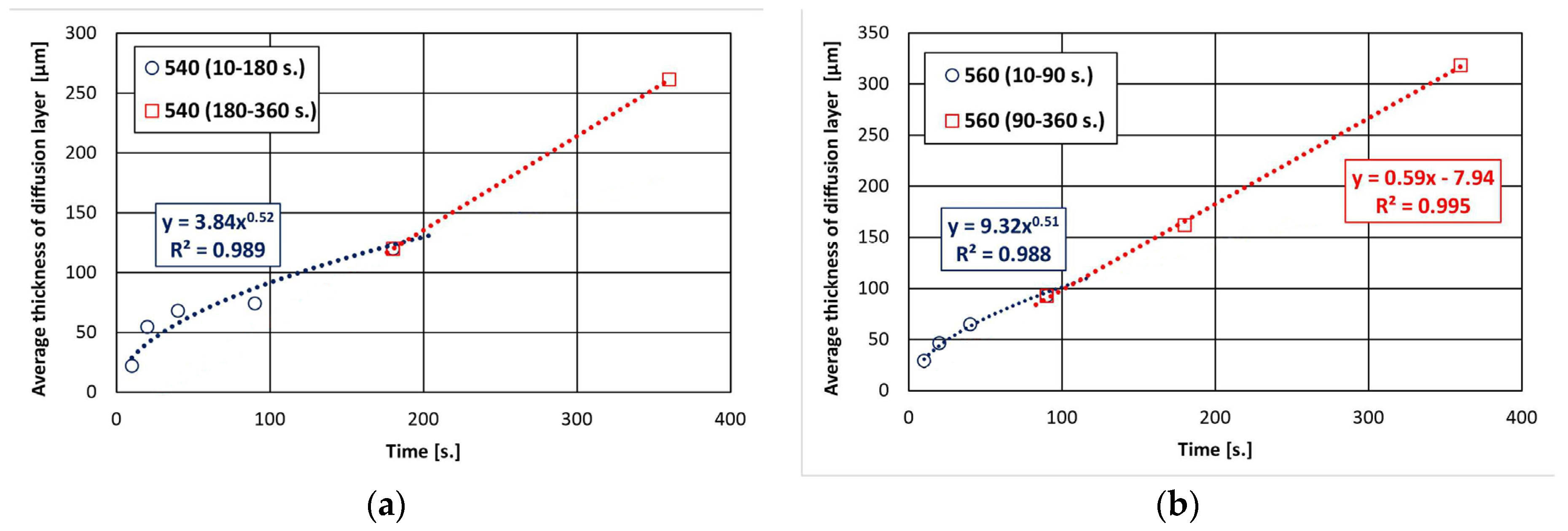


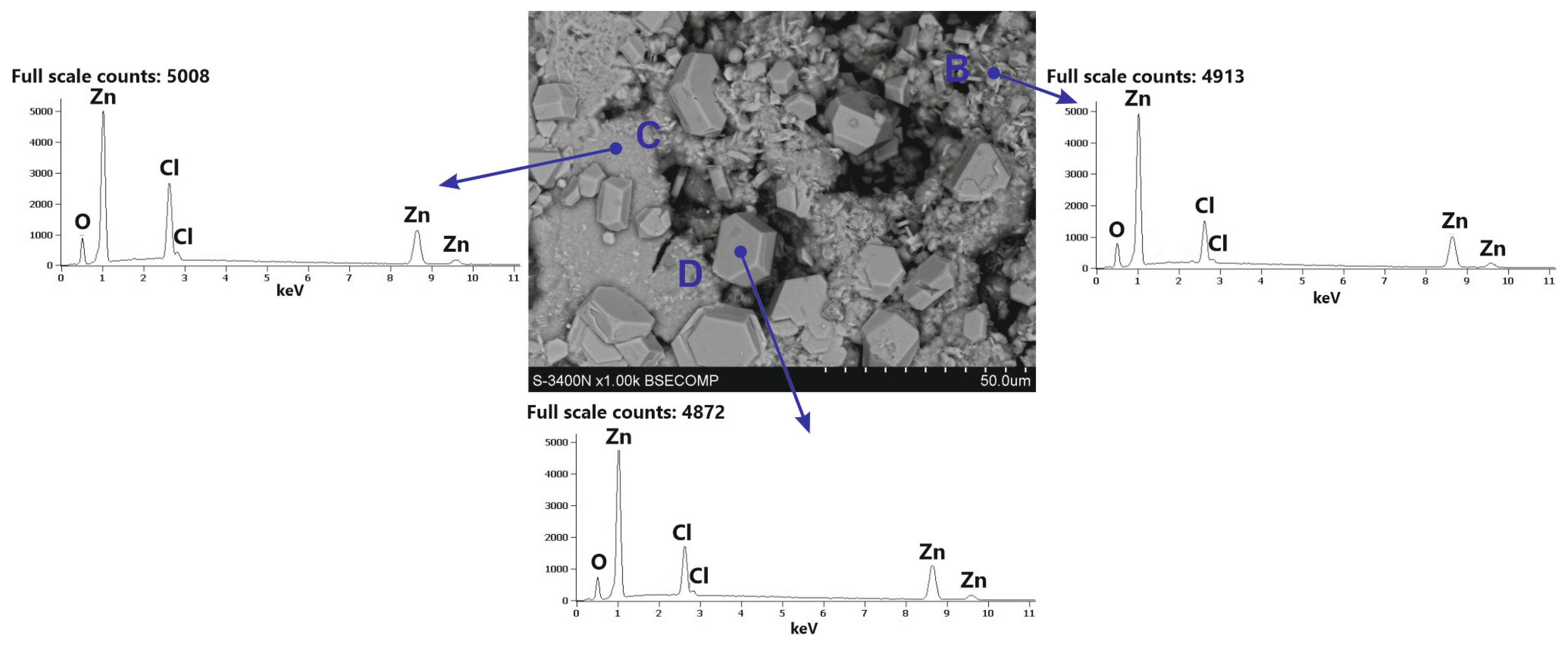
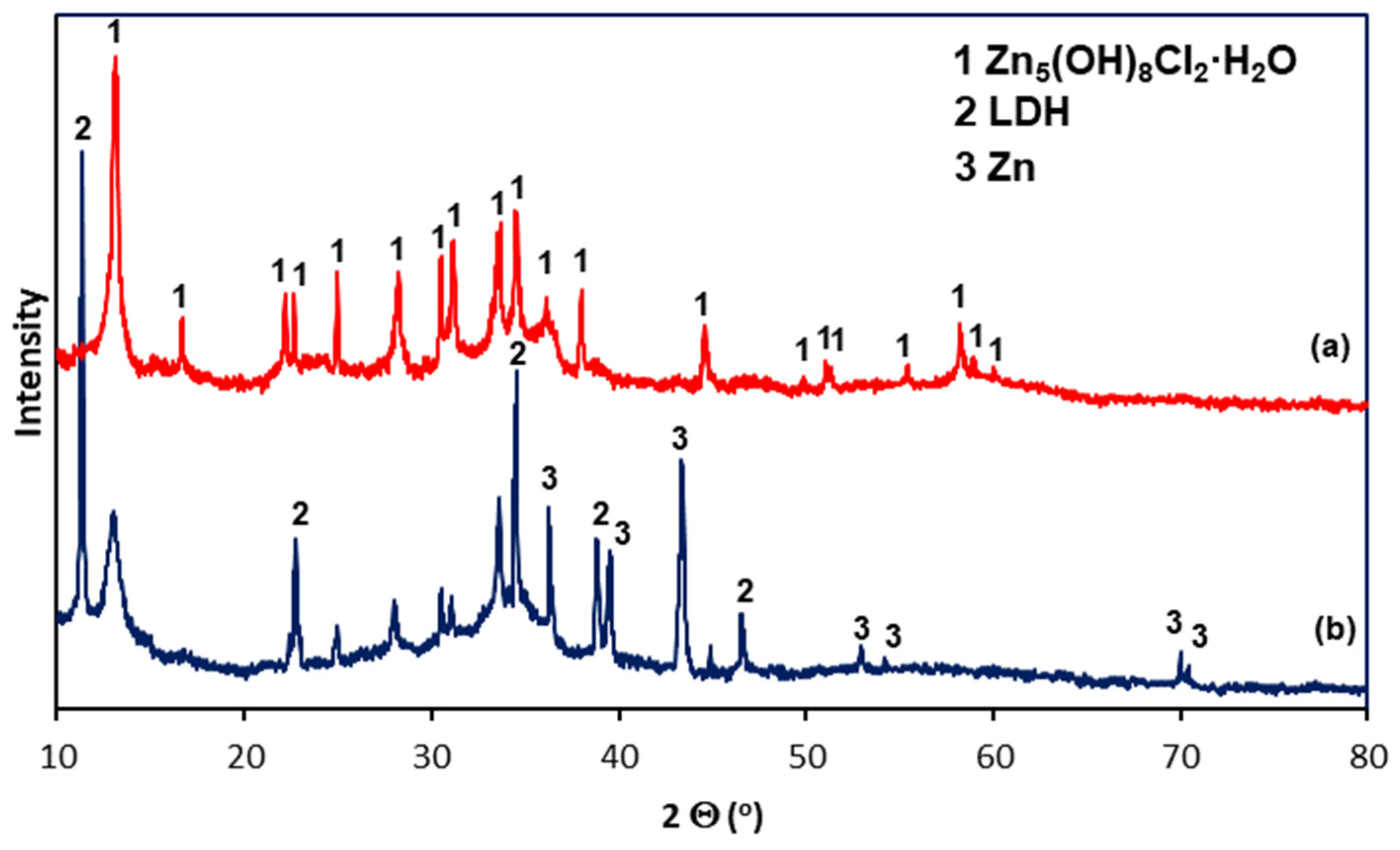

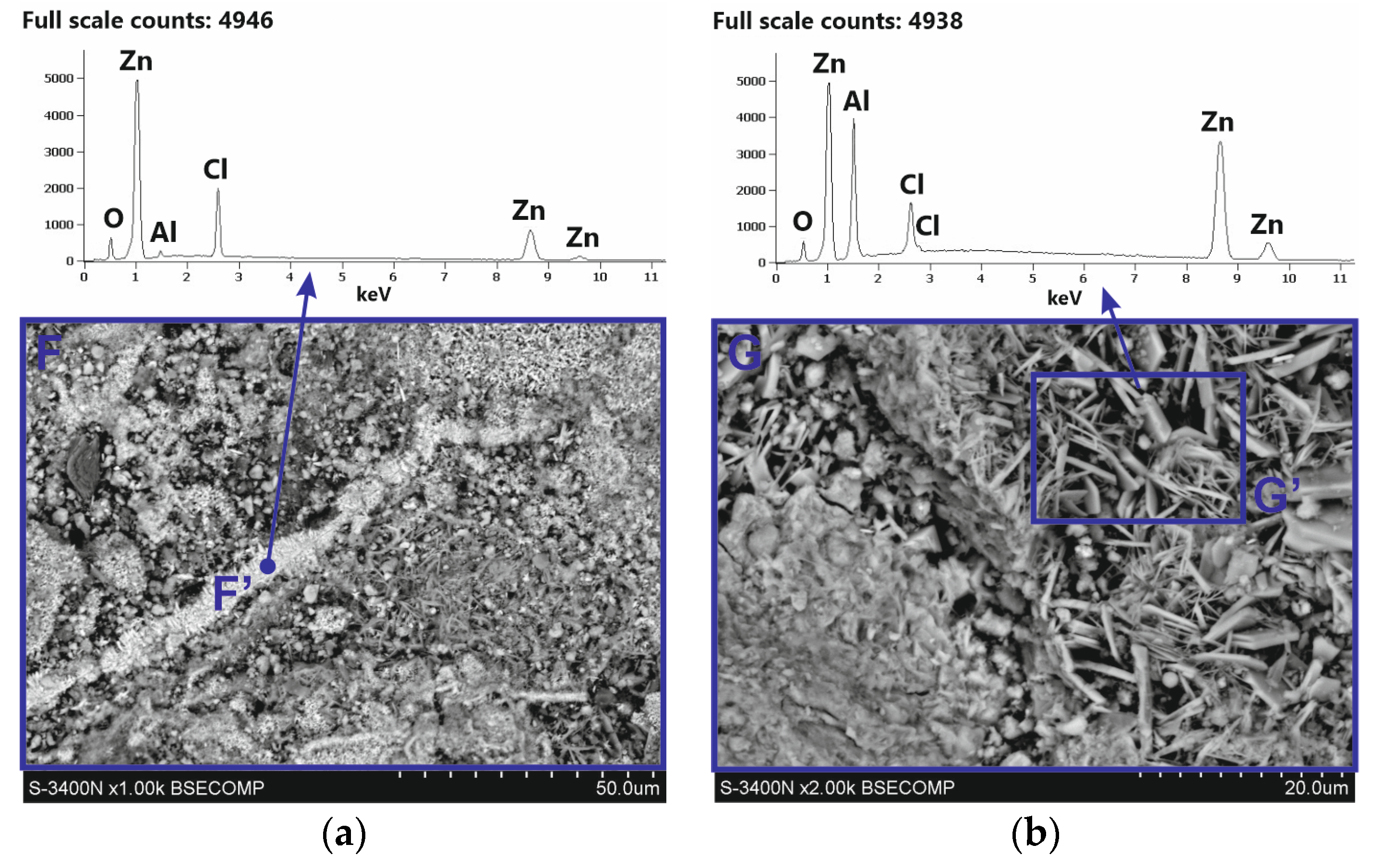
| Content [wt.%] | |||||||||
|---|---|---|---|---|---|---|---|---|---|
| C | Si | Mn | S | P | Cu | N | Fe and Others | ||
| Steel | B500B | 0.21 | 0.18 | 0.82 | 0.03 | 0.02 | 0.34 | 0.007 | rest |
| Al | Fe | Pb | Cd | Sn | Cu | Zn and others | |||
| Bath | Zn | 0.0062 | 0.033 | 0.0003 | 0.0002 | 0.0002 | 0.0003 | rest | |
| Zn-5Al | 5.17 | 0.031 | 0.002 | 0.0002 | 0.0002 | 0.0003 | rest | ||
Disclaimer/Publisher’s Note: The statements, opinions and data contained in all publications are solely those of the individual author(s) and contributor(s) and not of MDPI and/or the editor(s). MDPI and/or the editor(s) disclaim responsibility for any injury to people or property resulting from any ideas, methods, instructions or products referred to in the content. |
© 2024 by the authors. Licensee MDPI, Basel, Switzerland. This article is an open access article distributed under the terms and conditions of the Creative Commons Attribution (CC BY) license (https://creativecommons.org/licenses/by/4.0/).
Share and Cite
Marek, A.; Steinerová, V.; Pokorný, P.; Kania, H.; Berger, F. High-Temperature Zn-5Al Hot Dip Galvanizing of Reinforcement Steel. Coatings 2024, 14, 959. https://doi.org/10.3390/coatings14080959
Marek A, Steinerová V, Pokorný P, Kania H, Berger F. High-Temperature Zn-5Al Hot Dip Galvanizing of Reinforcement Steel. Coatings. 2024; 14(8):959. https://doi.org/10.3390/coatings14080959
Chicago/Turabian StyleMarek, Anżelina, Veronika Steinerová, Petr Pokorný, Henryk Kania, and Franciszek Berger. 2024. "High-Temperature Zn-5Al Hot Dip Galvanizing of Reinforcement Steel" Coatings 14, no. 8: 959. https://doi.org/10.3390/coatings14080959






